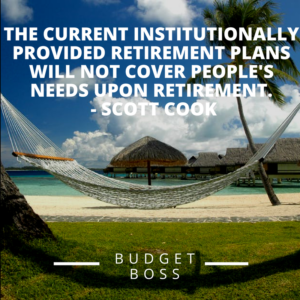Wednesday WTF: Wednesday, July 26, 2017
Government Sponsored Retirement Plans
Good morning friends and welcome back to Wednesday WTF, my weekly rant on things that waste your money. This week has been all about retirement here at Budget Boss. Today I am going to speak about the forms of government-sponsored retirement income. For many, the belief that you will receive a decent income in retirement from the government still exists. While you do receive money from the government of Canada to supplement your income in retirement, for most it is not nearly enough. There are also restrictions and conditions that apply to all income received from the government during retirement. The key is to understand what you will receive from these programs and then plan accordingly. Using these programs as they were intended, an income supplement is crucial. Using them as a sole means of income during retirement would prove costly. Let’s first start off by understanding what you can expect to receive during retirement from our government.
1) Old Age Security (OAS)
Amount of Income Provided: $570.52 per month ($6,846.24 annually)
Age of eligibility: 65 years old (changing to 67 in 2023)
Income eligibility: Anyone earning $71,592 or less receives full OAS income
-Those earning more than this amount have their OAS income “clawed back” at a rate of 15% of their net income
Eligibility Criteria: There are 2 categories regarding OAS eligibility
To receive a full OAS pension, a person must meet these conditions:
Category 1 – Lived in Canada for at least 40 years after turning 18, or
Category 2 – Born on or before July 1, 1952, and between the time the applicant turned 18 and July 1, 1977, the applicant lived in Canada for some period of time, and the applicant lived in Canada for the 10 years immediately before the application was approved.
If an applicant has not lived in Canada for all of the last ten years because they gave up residence in Canada at some time, an applicant may still qualify for a full pension if they meet both conditions below:
-Lived in Canada for the year immediately before the application was approved, and
–Prior to these last 10 years, the applicant lived in Canada after age 18 at least three times as long as the total of absences during the last 10 years.
If you do not qualify for full OAS income you can still receive partial income depending on other criteria. These rules show how inadequate OAS is when thinking of retirement savings.
2) Canadian Pension Plan (CPP)
Maximum amount of income provided: $1114.17 per month ($13,370.04 annually) 2017
Age of Eligibility: CPP can be taken as early as 60 or as late as 70
Income Eligibility: CPP benefits rely on your contributions throughout your lifetime. CPP essentially takes your best 39 working years to create the average of what you receive in retirement. To receive the maximum one would have to contribute what is called the “Yearly Maximum Pensionable Earnings” or YMPE. The YMPE is the amount you need to make to contribute enough to get the maximum CPP benefit in retirement. ($55,300 2017, up from $54,900 in 2016). You would have to contribute that amount for 39 years to receive maximum CPP benefits. Those who have low earning years for various reasons, (child rearing, education, job loss, etc.) fall short of this YMPE. Many others never reach the income level of YMPE. It is essential to know that most people do not receive the maximum amount of CPP benefits during retirement.
3) Guaranteed Income Supplement (GIS)
The GIS is an additional income for low-earning retiree’s that works along with Old Age Security.
Maximum amount of income provided: $864.09
Age of Eligibility: Once one receives OAS (Age 65)
There are certain criteria to receive the GIS. To receive maximum GIS one must:
- Single persons with total income less than $17,544.
- Married/common-law couple, both OAS pensioners, with combined total income less than $23,184
- OAS pensioners whose spouse/common-law partner is not receiving OAS, with combined annual income less than $42,048
The GIS is basically a supplement for those who do not receive CPP because they did not contribute enough during their lifetime. GIS income is “clawed back” much like OAS income on a 2 for 1 ratio.
Summary:
These three sources of retirement income leave many elder Canadians living in poverty during their retirement years. The absolute maximum you are eligible to receive in retirement from our government when you retire is around $21,000. Oh yeah, and all these government sponsored benefits are TAXABLE. This is why increasing your net worth during your earning years is vital. This includes personal savings, retirement savings and a paid off home. If you have to make housing payments on top of living expenses while receiving such a meager income it will be devastating. This is why even a small amount of money saved for retirement can help out greatly. Knowing these numbers is not meant to scare you, more like inform you. Having a well-rounded retirement savings plan including government benefits will allow your money to outlive you instead of the other way around.
Thanks for reading my post today and tune in tomorrow for “Thursday trim the Trash Time,” where I will discuss employment sponsored retirement benefits. Have a great day friends!
“The current institutionally provided retirement plans will not cover people’s needs upon retirement.” – Scott Cook

https://budgetboss.ca/tuesday-july-25-2017/
Facebook – @JoeBudgetBoss LinkedIn – Joseph James Francis Quora – Joseph James Francis
Twitter – @JoeBudgetBoss Instagram – @JoeBudgetBoss
Joseph James Francis is a Financial Advisor. You can find him on various social media platforms and at www.budgetboss.ca.

